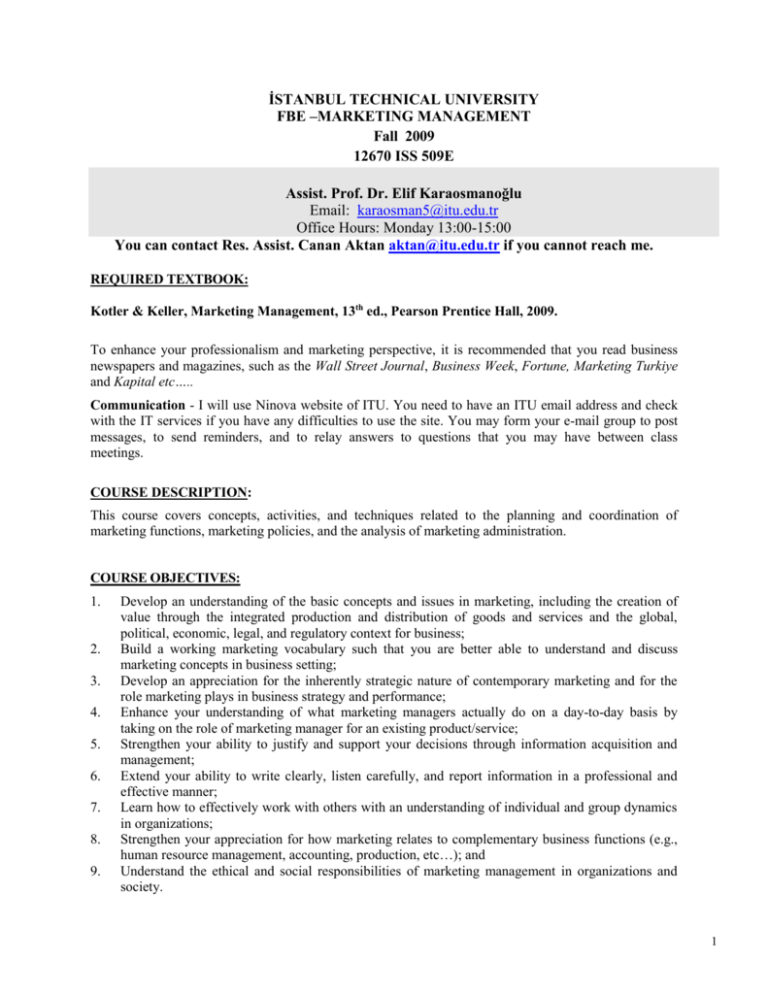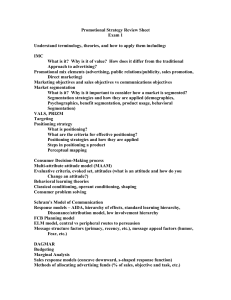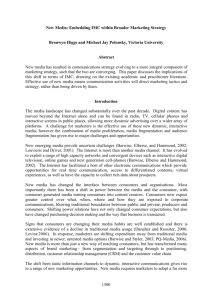
İSTANBUL TECHNICAL UNIVERSITY
FBE –MARKETING MANAGEMENT
Fall 2009
12670 ISS 509E
Assist. Prof. Dr. Elif Karaosmanoğlu
Email: karaosman5@itu.edu.tr
Office Hours: Monday 13:00-15:00
You can contact Res. Assist. Canan Aktan aktan@itu.edu.tr if you cannot reach me.
REQUIRED TEXTBOOK:
Kotler & Keller, Marketing Management, 13th ed., Pearson Prentice Hall, 2009.
To enhance your professionalism and marketing perspective, it is recommended that you read business
newspapers and magazines, such as the Wall Street Journal, Business Week, Fortune, Marketing Turkiye
and Kapital etc…..
Communication - I will use Ninova website of ITU. You need to have an ITU email address and check
with the IT services if you have any difficulties to use the site. You may form your e-mail group to post
messages, to send reminders, and to relay answers to questions that you may have between class
meetings.
COURSE DESCRIPTION:
This course covers concepts, activities, and techniques related to the planning and coordination of
marketing functions, marketing policies, and the analysis of marketing administration.
COURSE OBJECTIVES:
1.
2.
3.
4.
5.
6.
7.
8.
9.
Develop an understanding of the basic concepts and issues in marketing, including the creation of
value through the integrated production and distribution of goods and services and the global,
political, economic, legal, and regulatory context for business;
Build a working marketing vocabulary such that you are better able to understand and discuss
marketing concepts in business setting;
Develop an appreciation for the inherently strategic nature of contemporary marketing and for the
role marketing plays in business strategy and performance;
Enhance your understanding of what marketing managers actually do on a day-to-day basis by
taking on the role of marketing manager for an existing product/service;
Strengthen your ability to justify and support your decisions through information acquisition and
management;
Extend your ability to write clearly, listen carefully, and report information in a professional and
effective manner;
Learn how to effectively work with others with an understanding of individual and group dynamics
in organizations;
Strengthen your appreciation for how marketing relates to complementary business functions (e.g.,
human resource management, accounting, production, etc…); and
Understand the ethical and social responsibilities of marketing management in organizations and
society.
1
SKILLS YOU ARE EXPECTED TO BRING INTO THIS COURSE:
1. Written and oral communication skills necessary for achieving graduate status;
2. General understanding of the business and economic environment, finance, accounting, statistics, and
information technology;
3. Ability to analyze and use library materials, reference resources, and research reports; and
4. Teamwork skills.
POLICIES:
INSTRUCTIONAL METHODOLOGY:
1. Professional lectures;
2. Discussion of assigned CASES ;
3. In-class exercises, both group and individual;
4. Student written and oral presentations;
5. Classroom participation; and
6. Group Project
7. Take home midterm and in–class final exam.
GRADE EVALUATION:
Marketing Plan Team Project
Personal Assignment
Examinations (Midterm & Final Exam)
Case Presentations
TOTAL:
20%
15%
45%
20%
100%
ATTENDANCE: You are expected to not only attend, but to actively contribute to the learning
experience of the class. Poor attendance can significantly hurt your overall class participation grade.
1-EXAMINATIONS (45%)
There are two examinations based on the textbook, class lecture material, and the marketing plan project.
You are responsible for all assigned reading, even if the instructor does not cover it in class. No make-up
exams are given. Exam 1 (mid-term) is a take-home exam and Exam 2 (final exam) is an in-class exam.
To prepare for the exams, take an action-oriented and repetitive approach (outline chapters as you read;
rewrite major concepts as you study).
Exams are graded for level of quality in responses, including the use of appropriate marketing
language and relevant practical example.
MAKE-UP AND LATE WORK POLICY: Be sure to allow adequate time to solve unanticipated
problems with respect to deadlines. Submissions turned in late during class or within 24 hours of the
deadline will receive half credit. Submissions more than 24 hours late will not be accepted. Exceptions to
this policy may be granted for emergencies.
2
2-CASE DISCUSSIONS (20%)
The business community considers case analysis and discussion valuable learning tools. Since you have
done some case analysis in other courses, you should not have trouble with the assignments. Please do
not come to class just to listen. Come ready to contribute.
Every case leaves us with options. In order to generate interesting class discussions, we need people to
take opposing sides, and keep others honest by asking the right questions. Strong assertions (i.e.,
“Industrial equipment customers don’t care about brand.”) need to be supported by as many facts as the
case provides. Supporters or detractors of such assertions need to articulate their rationale clearly and
effectively. This is what I mean by being prepared.
To that end, ONE GROUP will be assigned the role of “devil’s advocates” for most cases, and a
different GROUP will be expected to serve as the primary “spokespersons” for the case discussion.
NOTE: UNASSIGNED PEOPLE SHOULD PICK ONE OF THE TWO POSITIONS AND
CONTRIBUTE ALSO.
Having spokespersons and devil’s advocates does not absolve the rest of the class from preparing the
case, but it places responsibility on some to prepare extra well.
3- INDIVIDUAL ASSIGNMENTS (15 %)
You have an option of choosing ONE of the following assignments as your first assignment. These
assignments are INDIVIDUAL work. All assignments must be professionally done, typed double-spaced
in 11 or 12-pt. font and should not exceed the page limit assigned. The page limit does not include the
cover page, table of contents and appendices.
The report is due at the beginning of class on the due date. Refer to the "Schedule" for Due Dates.
There is a 5-point penalty per day for late work.
Assignment 1:
Either Option 1 or 2 ….
Option 1: Competitive Analysis
This involves developing a competitive analysis between two (2) companies in an industry. Pick an
industry (based on your interest and/or information availability). Within this industry, choose two
companies such that:
A company which is doing well, and
A company which is not doing as well as above.
(Your selection of two companies will have to be approved by me, although you will be given
considerable freedom to follow your own interests. Since the project will require a significant amount of
time and effort it is important that you select companies in which you are personally very interested.)
The task is to:
Completely analyze and compare these two businesses with regard to their marketing practices. In
particular, you should focus on the analysis of marketing issues (e.g., customer, competitor,
3
industry, technology, government, self, product (features), pricing, advertising, sales promotions,
which you feel are important in explaining the differences between the performance of two
companies. Non-marketing reasons should be briefly mentioned. Of course, you will only focus
on the particular issues which are important for explaining the differences in performance
between the companies you have chosen.
Suggest actions and strategies (on each issue), which you feel would enable the weaker and
stronger company to improve its market position. Clearly outline your assumptions and thought
process.
In grading the report, I will use the creativity/originality and clarity of exposition, depth and
breadth of research as the criteria.
The deliverable is a 10-page clear, concise, and persuasive report.
Option 2: Segmentation and Positioning
This assignment intends to provide you with an in-depth understanding of the Segmentation, Target
market and Positioning (STP) practice. The object of your analysis will be studying the STP practice in
any Industry of your choice. Collect information on the following:
1. Overview of the Industry: How is it structured? Different "categories" of players in the industry.
2. How does each of these players segment the marketplace? (Process of Segmentation). What
segmentation variables do they employ?
3. What market /customer segments does the company pursue? (Choice of target market) Why? List
the factors (in order of preference) that the company uses in selecting the Target Market.
4. How do the companies "position" their offerings to their target segments? How do they match the
product/service characteristics with that of the target markets?
Prepare a 10-page report on the key findings of your STP analysis. Reports earning a grade of A
must include evidence of background reading (textbook, reference material, lecture notes etc) on
the topic.
4
COURSE SCHEDULE
WEEK
1
01/10
2
08/10
LECTURES
Chapter 1- Defining Marketing for the 21st Century
Chapter 2- Developing Marketing Strategies and Plans
3
15/10
No class
4
22/10
Chapter 3- Gathering Information and Scanning the Environment
Chapter 4- Conducting Marketing Research and Forecasting Demand
5
29/10
Republic Day
6
05/11
Chapter 5&6 - Analyzing Consumer Markets
Chapter 7 - Analyzing Business Markets
Chapter 8 - Identifying Market Segments and Targets
7
12/11
Chapter 9 - Creating Brand Equity
Chapter 10- Crafting the Brand Positioning
8
19/11
9
26/11
Chapter 11 – Dealing with the Competition
Chapter 12 - Setting Product Strategy
Case 1 - Marvel Enterprises, Inc. Göksu&Anıl
Case 2 – Dell – Elif&Duygu
Case 3 - Apple – Ersin&Umut
Case 4 - McKinsey – Barış&Mithat
Case 5 – Starbucks – Cihan&Yelda
Individual Assignment #1 due
Case 6 - Adidas - Kadir&Sezgin
Doctoral Presentation
Mid-term due ON THE 25th OF NOVEMBER
Kurban Bayramı
10
03/12
Chapter 13 - Designing and Managing Services
11
10/12
Chapter 14 - Developing Pricing Strategies and Programs
Chapter 15 – Distribution
12
17/12
CASES & ASSIGNMENTS
Chapter 16 - Retailing ,Wholesaling and Logistics
Case 7 – Eastman Kodak –
Anna&Damla
Case 8 - Heineken N.V.: Global
Branding and Advertising –
Oğuzhan&Erman
Doctoral Presentation
Case 9 – Cola Wars – Sarper&Emre
Case 10 - Zara –
Burak&Billur&Burcu
Case 11 - Google – Eren&Özgün
Case 12 - Walt Disney –
Cansu&Yağmur&Gonca
13
24/12
Chapter 17 - Designing and Managing Integrated Marketing
Communications
Chapter 18 - Managing Mass Communications: Advertising, Sales
Promotions, Events, and Public Relations
Case 13 - 7-Eleven – Esma&Manolya
Individual Assignment #2 due
14
31/12
Marketing Plan Presentations
Teams present marketing plans
(15 minutes each)
5
Assignment 2:
MUST ASSIGNMENT
Personal Marketing Plan: The Brand Called You
You will be developing a written marketing strategy designed to facilitate your reflective thinking,
professional development and career strategy. Worksheets from your professor support this assignment.
This project focuses on your professional goals, by developing your own marketing strategy for securing
a new position or advancing your career.
All assignments and the marketing plan must be computer generated (double-spaced, 12 pt. font, with
one-inch margin on all sides). Correct grammar, spelling, sentence structure, and word selection are
required. If you need any assistance, please contact the Writing Center at the Social Sciences Institute.
The center offers a developmental and word processing experts.
DEVELOPING YOUR MARKETING STRATEGY
I.
II.
III.
IV.
V.
VI.
Introduction (how paper is organized, why assignment is important to you)
Situation Analysis (significant life events, accomplishments, SWOT of self)
Objectives (“To have a job in six months” “To make $65,000 a year” “To work in Atlanta, GA”
“To enjoy my co-workers”)
Target Market (What position and new experiences am I seeking? Where do I fit?)
Profession type
Skills and interests required by position
Industry and organization type
Corporate culture and people factor (independence, structure)
Positioning and Core Strategy description (unique characteristics that differentiate you from
competitors; your brand statement)
Marketing Mix chart (improvements on product to reach target market, then place, price,
promotion tactics)
A. Product (Who am I? What makes me different?)
Likes and dislikes
Strengths and weaknesses
Features and benefits
Product positioning (relative to colleagues and competition)
Expertise, credibility, trustworthiness
Degrees, work experience, leadership activities, memberships
B. Price (what is my value to an employing organization? How much can I be compensated? How
much do I want or need?)
Salary and total compensation package
Brand value and equity
Negotiations with the prospective employer
Relative product quality and relationship to compensation package
Psychological and social rewards
C. Promotion (How do I enhance my visibility? How will I communicate with potential
employers?)
Persistence and motivation
Resume
6
Networking
New projects and connections
D. Distribution/Place (Where can I find this position? Where do I want to be? Where will I be
happiest?)
Geographical location
City or Suburb
Type of place – large corporation, own business, etc…
VII.
Action plan (timeline) and any Appendices (resume, cover letter, portfolio)
These are basic guidelines for your marketing strategy. I encourage you to be creative and use this
process to develop your unique plan for reaching career goals.
4-FINAL PROJECT - Marketing Plan Team Project (20%)
Critical Thinking: This project will require that each participant and each team assume the role of
“marketing manager” for one real-life product or service. The marketing plan team project is
analytically challenging, requires creativity, and facilitates improvements in oral and written
communication skills. Most marketing managers are highly skilled MBAs who are responsible for
overseeing one product or product line. In this regard, they make a variety of marketing decisions,
including those that focus on product issues (e.g., development, extension, and deletion), pricing
strategies (e.g., cost-based, demand-based, prestige), integrated marketing communications/promotion
programs (e.g., advertising, personal selling, sales promotion, publics relations etc.), and distribution
channel/supply chain management matters (e.g., intensity of market coverage, vertical marketing system
structure). The marketing manager makes these decisions within the context of ethical, global, political,
social, legal and regulatory, environmental, technological and competitive factors.
Written and Oral Communication: In small groups of four people (the number may change according
to class size), marketing management teams will write a comprehensive marketing plan and prepare
professional presentations with MS PowerPoint. Writing and presenting marketing plans provide an
opportunity to showcase your hard work, creative ideas, and marketing knowledge to peers and the
instructor.
Teamwork: The success of your team will greatly depend on the ability of the team members to work
together. Working well as a team requires that each member learns to cope with different personalities of
the other team members. A strong team does not let differences in schedules, age, gender, or experiences
interfere with their performance. If a team member does not carry his or her share of the work, that
individual should be warned of the need for improvement. I should be considered an ex officio member of
each group and kept apprised of developments, especially when the team is approaching the decision to
remove a team member for non-performance.
Team project scores may be adjusted for peer evaluations, so please ensure your strong commitment,
participation, and contribution to all team assignments. You will be providing feedback on team
members’ relative contributions and efforts. If an individual member’s contribution averages less than 90
percent, then he or she will receive that percentage of the team’s grade. Members whose overall
assessments total 90 percent or higher will receive the team’s grade.
7
Information Technology & Research: All data sources, including interviews, websites, company
reports, magazine articles, and others, must be referenced in the written report. Any material taken
directly from another source must be placed in “quotes” or properly reworded and sourced. The failure to
give full credit can be grounds for plagiarism.
ACADEMIC HONESTY: Submission of any work for a grade for which unauthorized help has been
received is termed academic dishonesty and will be grounds for a failing grade in the course.
"Unauthorized" is a term used here to designate stealing, copying (with or without permission),
collaboration with other individuals or sharing programming code outside of sanctioned group activities.
Students are strongly encouraged to refer to the BU student handbook for policies related to academic
dishonesty.
CLASSROOM CIVILITY: Classroom professionalism and civility are to be maintained at all times.
To create an environment that is conducive for teaching and learning, appropriate social conduct is
required. Pagers and cellular phones are to be turned off or set to vibrate.
MARKETING PLAN PROJECT:
The course is designed so class topics and discussions are directly tied to the marketing plan project.
Sample plans and marketing plan worksheets are available. Students are required to plan and write a
marketing management project and present their findings in a formal report.
Presenting Your Marketing Plan
The following outline is a guide for developing the oral presentation for your marketing plan.
Please present the information in a succinct, persuasive and enthusiastic manner.
1. Most Relevant External, Internal and SWOT Factors (4-5 points total)
2. Goals and Objectives for Marketing Strategy (use chart for presentation)
a. Qualitative Goals
b. Quantitative Objectives
c. Justification (very important to show integration)
3. Marketing Strategy and Tactics, Recommendations
a. Describe Customer Group for this Strategy
b. Benefits Sought by this Customer Group
c. Internal Theme of the Marketing Strategy (helps audience remember key points)
4. Elements of the Marketing Strategy (use a chart)
a. Product (new, maintain)
b. Pricing (new, maintain)
c. Placement and Distribution (new, maintain)
d. Promotion and Communication (new, maintain)
5. Integration of Strategy (how 4 Ps work together; reinforce theme; “sell” it to
audience).COURSE OUTLINE
8
Some Academic Journals:
Academy of Management Review
Academy of Management Journal
Strategic Management Journal
Journal of Management Information Systems
Journal of Management Research
Journal of Management Science
Journal of Management Studies
Journal of Manufacturing Technology Management
Journal of Marketing
Journal of Marketing Research
Journal of Consumer Research
Journal of Retailing
Journal of the Academy of Marketing Science
Journal of Business Research
Journal of Advertising
Journal of Advertising Research
Journal of Personal Selling and Sales Management
Journal of Public Policy and Marketing
Journal of Applied Psychology
Psychology and Marketing
Journal of International Business Studies
Industrial Marketing Management
Journal of International Marketing
Journal of Services Marketing
International Journal of Research in Marketing
Journal of Consumer Psychology
Journal of Marketing Theory and Practice
European Journal of Marketing
Journal of Health Care Marketing
Journal of Product Innovation Management
Journal of Business and Industrial Marketing
Journal of Business Ethics
Journal of Business Logistics
Journal of Personal Selling and Sales Management
Advances in Consumer Research
Marketing Intelligence and Planning
Journal of Services Marketing
Journal of Business Logistics
Journal of Operations Management
9










